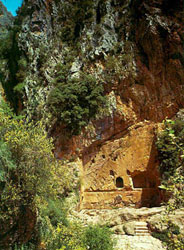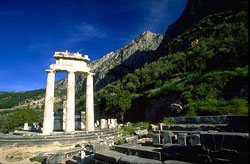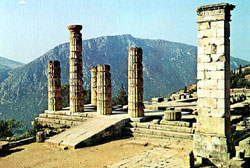Delphi
The Tholos Temple, Sanctuary of Athena Pronaia
Later repenting of his crime, Apollo purified himself (on the
island of Crete) and, returning to Delphi, persuaded Pan (the goat-god of
wild places and evocative music) to reveal to him the art of prophecy.
Upon the site of his battle, Apollo erected his own oracular temple and, at
the exact place where he had 'speared' the serpent, an omphalos
stone was set in the ground.
Regarding the omphalos, one
legend tells that the original stone, now lost, was a large meteorite
fallen from the sky in deepest antiquity, while another legend says it was
the first physical object to emerge on dry land after the waters of
the Deluge had settled. The omphalos stone currently on
display in the Delphi museum, while very old and indeed from Delphi, is thus
not the original sacred stone. It is interesting to inspect this exhibited
stone however, for its conical form and sculptural designs derive from the
old pillar and tree worship of the prehistoric goddess cults.
The oracular use of the site continued during Apollo's occupation and, through the endeavors of politically astute priests, Delphi achieved Panhellenic fame as a major oracle shrine by the 7th century BC.
Until recently this matter was considered to be a fabrication from post-Delphic times. French archaeologists began excavating the ruins in 1892, digging down to the temple's foundations, but no evidence of a fissure or fumes was found. By 1904, a visiting English scholar, A. P. Oppé, declared that ancient beliefs in temple fumes were the result of myth, mistake or fraud.
The Oxford Classical Dictionary in 1948 voiced the prevailing view:
During the late 1990’s however, a geologist, an archaeologist, a chemist and a toxicologist teamed up to produce a wealth of evidence suggesting that the ancient legends had in fact been accurate.
The region's underlying rocks
turn out to be composed of oily limestone fractured by two hidden
faults that cross exactly under the ruined temple, creating a path
by which petrochemical fumes (methane, ethane and ethylene) could rise to
the surface to help induce visions. In particular, the scientists found that
the women communing with the oracle probably came under the influence of
ethylene - a sweet-smelling but psychoactively potent gas once
used as an anesthetic. In light doses, ethylene produces feelings of
disembodied euphoria and visionary insight.
The answers, interpreted by male priests and then spoken in verse, proved so accurate that the Delphic oracle came to exercise enormous political and social influence in the Greek empire for nearly a thousand years. Historical sources indicate that the Delphic oracle was open only one day per month during the nine months of the year when Apollo was considered to be resident at the site. For a variety of reasons the Delphic oracle was in decline by the 1st century AD and the last recorded oracle was in 362 AD.
The Christian emperor Theodosius officially
closed the vast temple in 393 AD, thereby signaling the end of the ancient
tradition of Greek oracles and the ascendancy of the new god of
Christianity. Delphi was abandoned to the elements and
gradually fell into ruins.
The omphalos stone, and the earlier marker stone it replaced, were used to gather, concentrate and emanate the energies of the power place for the benefit of the local people.
From earliest times the particular energy of the site, as well as the chemical vapors rising from deep within the earth, had been recognized to induce prophetic visions in people and as a consequence a quasi-religious cult had developed over time.
A guardian of wisdom and spiritual consciousness, Athena continued the ancient veneration of the feminine principle and brought devotion to the Earth Mother into the Classical Age of Greece. The Tholos temple, built in the early 4th century BC, has an unusual circular shape.
This shape, and the leaf-adorned capitals of its Corinthian columns are a representation of the sacred forest groves of the old Earth Goddess religion. Writing in The Earth, The Temple, and The Gods, Vincent Skully comments that
Mt. Parnassus, in addition to its other mythological associations, holds a similar position in Greek legends as Mt. Ararat holds in the Old Testament.
After the waters of a great flood receded, an ark-like boat carrying Deucalion and his wife Pyrrha landed on Mt. Parnassus. High upon the mountain, Deucalion sought advice from Themis, the resident earth goddess, regarding how to repopulate the earth with humans.
Themis instructed Deucalion and Pyrrha to throw rocks over their shoulder, these being the “bones” of the Earth Mother, and that the stones would be transformed into the first human beings. Themis (who was another daughter of Gaia, by Uranus) also figures in an alternate legend of the Delphic oracle. In this account, Themis succeeded Gaia as the guardian of sacred Mt. Parnassus and later instructed Apollo in the arts of prophecy.
In these myths, Apollo does not kill the serpent Python, but rather an evil dragoness known as Delphyne.
Further adding to the mystery of Delphi are the studies of ancient mysteries researchers, Paul Broadhurst and Hamish Miller.
Following their exploration and mapping of alignments of sacred sites along the so-called St. Michael and Mary lines in southern England (chronicled in their book The Sun and the Serpent), Broadhurst and Miller spent ten years studying another alignment that passes through the temple of Delphi.
Beginning at Skellig Michael in Ireland, the remarkable alignment stretches 2500 miles, passing through numerous ancient holy sites in Cornwall, France, Italy, Greece and Israel.
Readers interested in learning more about this alignment of sacred sites and its fascinating relationship to the oracular temple of Delphi will enjoy The Dance of the Dragon by Broadhurst and Miller. |



